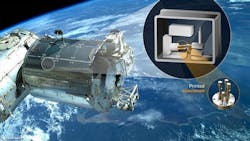Behind the scenes of the first metal part to be 3D-printed aboard the ISS
INTERNATIONAL SPACE STATION - After seven months in space, the first metal 3D part was printed onboard the International Space Station (ISS), 400 kilometers above the Earth. How did the team do it? Airbus writes. Continue reading original article.
The Military & Aerospace Electronics take:
11 September 2024 - In January 2024, the European Space Agency’s (ESA) metal 3D printer, the first to be installed on a space station, successfully arrived on board the ISS. Built by Airbus and its partners*, the printer’s objective is to demonstrate the feasibility of metallic part production in microgravity, opening the way to new on-orbit manufacturing capabilities.
Once the printer had been installed on board the ISS’ Columbus module in May this year, and the printer door hermetically sealed by ESA astronaut Andreas Mogensen, the printing process began. Print operations were overseen at the French space agency CNES, from the control center for ISS payloads. Two operators from Airbus and CNES ensured that the process ran smoothly.
While the process of 3D printing has been mastered on Earth, printing metal in space presents its own set of technical challenges. Sébastien Girault, metal 3D printer system engineer at Airbus, explains. “The first challenge with this technology demonstrator was size. On Earth, current metal 3D printers are installed in a minimum ten square metre laboratory, “ he says. “To create the prototype for the ISS, we had to shrink the printer to the size of a washing machine”. This miniaturisation is needed in order to fit inside the rack in which the printer will be housed on board the ISS’ Columbus Laboratory. “At this size, we can print parts with a volume of nine centimetres high and five centimetres wide,” Girault says.
Related: The world’s first metal 3D printer for space is on its way to the ISS
Jamie Whitney, Senior Editor
Military + Aerospace Electronics
